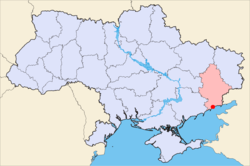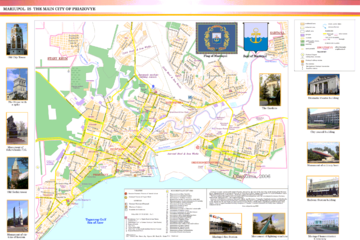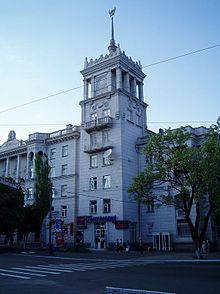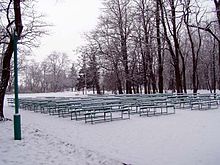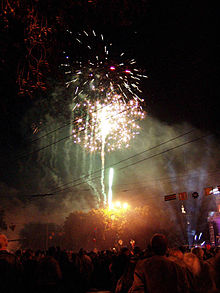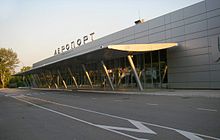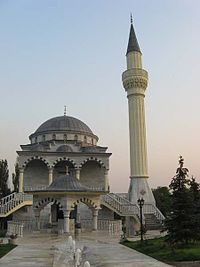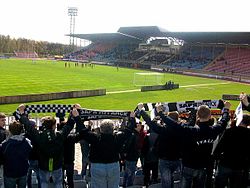- Mariupol
-
Mariupol
Маріуполь
Flag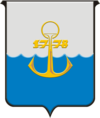
Coat of armsMap of Ukraine with Mariupol highlighted. Location of Mariupol Coordinates: 47°7′0″N 37°33′0″E / 47.116667°N 37.55°ECoordinates: 47°7′0″N 37°33′0″E / 47.116667°N 37.55°E Country
Oblast
RaionUkraine
Donetsk Oblast
Mariupol City MunicipalityFounded 1778 City rights 1779 Government - Mayor Yury Yuryevich Khotlubey Area - City 166 km2 (64.1 sq mi) Population (01.06.2010[1]) - City 490,063 - Density 2,058/km2 (5,330.2/sq mi) - Metro 519,000[citation needed] Postal code 87500—87590 Area code(s) +380 629 Website www.marsovet.org.ua Mariupol (Ukrainian: Маріуполь, pronounced [mariˈupʌlʲ]; Russian: Мариу́поль; Greek: Μαριούπολη), formerly known as Zhdanov (Ukrainian and Russian: Жда́нов), is a port city in southeastern Ukraine. It is located on the coast of the Azov Sea, at the mouth of the Kalmius River. Mariupol is the largest city in Priazovye - a geographical region around Azov Sea, divided by Russia and Ukraine - and is also a popular sea resort. Administratively, the city is located in the Donetsk oblast and historically formed a part of the broader Donbas region. As of June 1, 2010, the city population stood at 490,063 people.[1]
Mariupol is an important industrial centre and seaport. Two of its steel mills - Ilyich Iron and Steel Works and Azovstal - are among the largest in the country and make up a significant part of Ukraine's total exports.[citation needed] «Azovmash», a machine-building concern, located in Mariupol, is the largest company of its kind in Ukraine. Overall, Mariupol industry accounts for 37.5% of Donetsk oblast’s total exports and about 7.0% of all Ukraine’s exports.[citation needed]
From 1948 to 1989 the city was named Zhdanov in honour of Andrei Zhdanov.
Contents
History
Main article: History of MariupolMariupol was known from the beginning of the 16th century as the Cossack fortress Kalmius, but only became a real city after the migration of the Crimean Greeks to Priazovye from 1778 - 1780.
In 1779 it became the first city in the present Donetsk Oblast to receive city status. The railway, a new big port, and a metal works appeared at the end of the 19th century. The city has undergone much industrialisation, such as the appearance of a large "Azovstal" plant.
Mariupol was occupied by Nazi Germany from (1941–1943). It was one of two Soviet cities where Hitler stayed for a night (the other being Vinnitsa). The war caused tremendous damage to the city, with its factories and port facilities laid to waste and significant part of population killed. Now it is not a major centre of industry in the Donetsk Oblast, and a resort destination. It is recognised as the centre of Greek culture in Ukraine.
City image
Today Mariupol is the second most populous city in Donetsk oblast, (after Donetsk) and is among ten most populous cities in Ukraine. See List of cities in Ukraine.
Architecture
Old Mariupol (an area limited to the south coast of the Sea of Azov, in the east - Kalmius River, in the north - Shevchenko Blvd., in the West – Metalurhiv Av.) is built up mainly of few-story houses and has kept its pre-revolutionary architecture. Only Artem Street and Lenin Avenue were built after the Great Patriotic War and are considered modern buildings.
The central area of Mariupol (from the Metalurhiv Avenue up to Budivelnykiv Avenue) is almost entirely administrative and commercial buildings, including a city council building, post office, the Lukov cinema, Mariupol Humanitarian University, Priazov State Technical University, the Korolenko central city library, and many large shops.
Architecture of other residential areas ("Zakhidny", "Skhidny", "Kirov", "Cheremushky", 5th, 17th catchment area, etc.) are not especially different or original and are typically 5 and 9-storey houses. Cheremushki carries a special meaning in Russian culture and now entwined with Ukrainian. It usually refers to the newly settled parts of a city in Russia.
The accommodation of the city is 9.82 million meters square the common area. Security of the inhabited parts of the city is 19.3 meters square per 1 inhabitant. Densities of privatised habitation in 2003 were 76.3%.
Main streets
- Avenues (“Prospects”): Lenin (the central highway), Metalurhiv (“Metallurgists”, one connects 3 right-bank areas of city), Budivelnykiv (“Builders”), Ilyich (after Vladimir Ilyich Lenin), Nakhimov, Peremohy (“Victory”), Lunin (after admiral Lunin), Leningradsky (in Ordzhonikidzivsky Raion)
- Streets (“Vulitsi”): Artem, Torhova (“Trading”), Apatov, Kuprin, Uritsky, Bakhchivandzhi, Gagarin, Karpinsky, Mamin-Sibiryak, Taganrog, Olympic, Azovstal, Makar Mazay, Karl Libknekht.
- Boulevards: Shevchenko, Komsomol, Prymore (Sea), Khmelnytsky etc.
- Squares (“Ploscha”): Administrative (“Administrative”), Nezalezhnosti (“Independence”), Peremohy (“Victory”), Mashinobudivnykiv (“Mechanical engineers”), Lenin's Komsomol, Vyzvolennia (“Liberation”).
In December, 1991 by the decision of city council of Mariupol the following Soviet names of some streets have been renamed to their pre-revolutionary names in an old part of city:
- First of May Street - Heorhiyevska Street,
- Third International Street - Torhova Street,
- Apatov Street (a part - to the east from the Metalurhiv Avenue) - Italian Street,
- Donbass Street - Mykolaivska Street,
- Ivan Franko Street - Fontanna Street,
- Karl Libknekht Street (a part - to the east from the Metalurhiv Avenue) - Mitropolit Street,
- Karl Marks Street - Greek Street,
- Komsomol Street – Yevpatoriya Street,
- Krasnoarmeyskaya Street - Gotfeyska Street,
- Kuindzhi Street - Karasivska Street,
- Proletarian Street - Kaffayska Street,
- Rose Luxembourg Street - Zemska Street,
- Soviet Street - Harlampiy Street.
From 1990–2000 the following streets and areas have been renamed:
- Sergo Street - Jacob Gugel' Street (in Ordzhonikidzivsky Raion) - in honour of the head of construction and the first director of "Azovstal",
- Republic Lane - University Street (in city centre),
- Constitution Square - Mashinobudivnykiv (“Mechanical engineers”) Square,
- Square near to "Neptune" swimming pool – Nezalezhnosti (“Independence”) Square.
See also - List of streets and squares of Mariupol.
Parks
- City Square (« the Theatrical Square »),
- Extreme Park (new attractions near to the biggest in city of the Palace of Culture of Metallurgists),
- Gurov's Meadow-park (former Meadow-park a name of the 200-anniversary of Mariupol),
- City Garden (Russian: Горсад, «Children's Central Public Garden»),
- Veselka Park (Ordzhonikidzivsky Raion), named as the rainbow
- Azovstal Park (Ordzhonikidzivsky Raion),
- Petrovsky Park (near modern stadium “Illyichivets” and constructions of “Azovmash” basketball club, Illyichivsky Raion),
- Primorsky Park (Prymorsky Raion).
Monuments
Main article: Monuments of MariupolMariupol has monuments to Taras Shevchenko, Vladimir Vysotsky, Kuindzhi, Vladimir Lenin and many other famous persons. The monuments in honour of the liberation of Donbass, the metallurgists, and others can also be found.
There are also monuments to Makar Maza, Hryhoriy Yuriyovych Horban, K.P. Apatov, Tolya Balabukha, to seamen - commandos, pilots V.G. Semenyshyn and N.E. Lavytsky, soldiers of the Soviet 9th Aviation Division, victims of political repressions of 1930-50, etc. During the Soviet times the central square of the city was decorated with the monument to ZhdanovTemplate:Dismabiguate after whom the city was named for sometime (it was demounted in 1990). The artists V. Konstantynov and L. Kuzminkov are sculptors of some of the monuments and also created the monument to metropolitan Ignatiy, the founder of Mariupol.
City holidays
Holidays exclusive to Mariupol include:
- Day of liberation of the city from fascist aggressors (on September 10)
- Day of the city (the following Sunday after the day of liberation of Mariupol in September)
- Day of the metallurgist - a professional holiday for many citizens
- Day of the machine engineer
- Day of the seaman and other professional holidays.
Hotels
- Azovstal
- Chaika (“Seagull”)
- Druzhba (“Friendship”)
- European
- Meridian
- Morskaya (“Sea”)
- Moryak (“Seaman”)
- Priazovye
- Sniper
- Spartak
- Tourist
There are about 1 000 hotel rooms in the city in total.
Casinos & night clubs
- Broadway
- Pharaon (Pharaoh)
- Coral
- Imperiya (“Empire”)
- Keglik
- Lagoon
- Maxim
- Riviera
- Paradox
- Arlekin
- Split
- Pena
- Turist
- Ledo
- Horosho
Emblem
Main article: Coat of arms of MariupolThe modern emblem of Mariupol was confirmed in 1989. In the shield is the anchor with a ring as a ladle with poured metal. The number 1778 indicates the year of the city’s founding. The argent symbolises steel, azure means sea, the anchor represents the port, and the ladle is for metallurgy.
Administrative division
Main article: Administrative division of MariupolMariupol is divided into four neighborhoods or 'raions'. There are:
- Ilyichivsky Raion (after Vladimir Ilyich Lenin ) is the northern part of the city, the largest and most industrialized neighborhood in the city. Commonly known as: Zavod (“Factory”) of Ilyich.
- Ordzhonikidzivsky Raion (after Sergo Ordzhonikidze) is at the east part of the city, on the left coast of Kalmius river. Common name: the Left Coast.
- Prymorsky Raion is in the south of the city, on the coast of the Azov Sea. The everyday name of the central part this neighbourhood is simply "Port".
- Zhovtnevy Raion (Russian: Oktyabrsky – after the Great October Revolution, 1917) is the central city raion. The everyday name of the raion is simply "the Centre", or "the City".
The Kalmius river separates the Ordzhonekidzivsky Raion from the remaining three raions. Mostly the population is concentrated in the Zhovtnevy and the Prymorsky Raions. Ilyichivsky Raion houses the large Ilyich's steel mill and the Azovmash manufacturing plant. The Ordzhonekidzivsky (Left Bank) is home to the Azovstal metallurgic combine and the Koksohim factory. The map also shows that settlements of Stary Krym and Sartana are located in the close proximity to the city limits of Mariupol.
Demographics
Main article: Demographics of MariupolAs of June 1, 2010, the city's population was 490,063 inhabitants.[1] For the last century the population has grown almost 12 times. The city is populated by Ukrainians, Russians, Greeks, Belarusians, Armenians, Jews, etc. The main language is Russian.
Historical Populations[citation needed] Year City proper Change Metropolitan Change 1778 168 - 168 - 1782 2,948 +1,655% 2,948 +1,655% 1850 4,579 +55.33% 4,579 +55.33% 1897 31,800 +594.47% 31,800 +594.47% 1913 58,000 +82.39% 58,000 +82.39% 1939 221,500 +281.90% 221,500 +281.90% 1941 241,000 +8.80% 241,000 +8.80% 1943 85,000 -64.73% 85,000 -64.73% 1959 283,600 +233.65% 299,100 +251.88% 1979 502,600 +77.22% 525,000 +75.53% 1987 529,000 +5.25% 552,300 +5.20% 1989 518,900 -1.91% 541,000 -2.05% 1994 520,700 0.35% 543,600 0.48% 1998 499,800 -4.01% 521,300 -4.10% 2001 492,200 -1.52% 514,500 -1.30% 2002 489,700 -0.51% 510,800 -0.72% 2005 481,600 -1.65% 502,800 -1.57% 2007 498,600 +3.53% - - The population in 2007 was estimated at 496,700, with the subordinated territories (settlement Sartana, settlement Talakivka, settlement Stary Krym, village Hnutove, and village Lomakine) - 502,800. Annual reduction of the population is 1,9. The death rate is 15,5.[citation needed]
Ethnic structure
Ukrainian make less than half of the population of the city, the second greatest ethnicity of Mariupol is Russian. Other peoples include Greeks, Jews, Armenians, Belarusians, etc. The city home to the largest Greek population in Ukraine ("Greeks of Priazovye"): 21,900, with 31,400 more in the six nearby rural areas, totaling to about 70% of the Greek population of the area and 60% for the country.
Ethnic structure in 2002.
Ethnicity Number (person) Densities (%) Ukrainian 248,683 48.7 Russian 226,848 44.4 Greek 21,923 4.3 Belarusian 3,858 0.8 Armenian 1,205 0.2 Jews 1,176 0.2 Bulgarian 1,082 0.2 other 6,060 1.2 All population 510,835 100 Language structure
There is a large number of Greek-speaking (Rumaiic) people but the city is predominantly Russian-speaking. From 60% up to 80% Ukrainian-language dwellers communicate on so-called Surzhyk, due to a large influence of Russian culture.
Most Greek-speaking villages in the region speak a dialect called Rumaiica. There are about 17 villages that speak this language today. Modern scholars distinguish five subdialects of Rumaiica according to their similarity to standard Modern Greek. This was derived from the dialect of the original settlers from the Crimea. Quite often Rumaiica is described as a Pontic dialect. This is, in fact, not the case. Many Romaiic features are similar to those found in Cretan, Cypriot and Northern Greek dialects. As we still do not have a detailed description of Greek dialects, Rumaiica should be regarded as a separate unit in Greek dialectology.
The village of Anadol speaks Pontic proper, being settled from the Pontos in the 19th century.
Along with those speaking Rumaiica, there were and are a number of Tatar speaking Orthodox villages, the so called Urums, which is the Tatar term for Romaios or Rumei. This subdivision had already occurred in Crimea before the settlement of the Azov Sea steppe region by Greeks which started in 1779, part of the Russian policy to populate and develop the region while depriving the Crimea of an economically active part of its population.
Though Greek and Tatar speaking settlers live separately, the language of the Urums was the lingua franca of the region for a long time, being called the language of the bazaar. There are a number of settlements of other communities also, including Germans, Bulgarians and Albanians (though the meanings of all such terms in this context is open to dispute).
After the October Revolution of 1917, a Rumaiic revival occurred in the region. The Soviet administration established a Greek-Rumaiic theater, several magazines and newspaper and a number of Rumaiic language schools. The best Rumaiic poet Georgi Kostoprav created a Rumaiic poetic language for his work. This process was reversed in 1937 as Kostoprav and many other Rumaiics and Urums were killed as part of Joseph Stalin's national policies. A large percentage of the population was transported to Gulags.
A new attempt to preserve a sense of ethnic Rumaiic identity started in the mid-1980s. The Ukrainian scholar Andriy Biletsky created a new Slavonic alphabet for Greek-speakers. Though a number of writers and poets make use of this alphabet, the population of the region rarely uses it. The Rumaiic language is declining rapidly, most endangered by the standard Modern Greek which is taught in schools and the local University. The latest investigations by Alexandra Gromova demonstrate that there is still hope that elements of the Rumaiic population will continue to use the dialect.[2]
Language structure in 2002
Language Number (person) Densities (%) Russian 457,931 89.64 Ukrainian 50,656 9.92 Greek 1,046 0.20 Armenian 372 0.07 Belarusian 266 0.05 Bulgarian 55 0.01 other 509 0.10 All population 510,835 100 Employment
About 59% of the people whose occupation is in a national economy work in the industry, 11% of them in transportation[citation needed]. As of July 1, 2009, the official rate of unemployment in the city stood at 2%.[3] The figure, however, only includes people registered as 'unemployed' in the local job center. The real unemployment rate is therefore higher.
Historic Unemployment Rate in Mariupol (year end)[3][4][5][6]
Year Unemployment (% of labor force) 2006 0.4 2007 0.4 2008 1.2 2009* 2.0 * - as of July 1
Geography & ecology
Geography
Mariupol is to the south of the Donetsk area, on the coast of the Azov Sea, in a mouth of the river Kalmius. The city occupies an area of 166.0 km (103.1 mi) ² (64 mi²) (with suburbs, i.e., the territories subordinated to the Mariupol city council – 244.0 km (151.6 mi) ² (94.2 mi²)). The down-town area is 106.0 km (65.9 mi) ² (40.9 mi²), the area of parks and gardens is 80.6 km (50.1 mi) ² (31.1 mi²). The city is mainly built on land that is made of Solonetzic chernozems, with a significant amount of underground subsoil waters that frequently leads to landslides.
Climate
There is a moderate-continental climate with recurring droughts and dry winds in the summer and thawing weather, fogs - in the winter. Annual precipitation is 400 mm (15.75 in) a year. Agro climatic conditions allow the cultivation in suburbs of Mariupol thermophilic agricultural crops with long vegetative periods (sunflower, melons, grapes, etc.). However water resources in the region are insufficient, and consequently ponds and water basins are used for the needs of the population and industry.
Direction of a wind in the winter mainly east, in the summer - northern.
Average temperature of air in January 22.6 °F (−5.2 °C), in July 72.9 °F (22.7 °C). Quantity of deposits – 450 mm annually.
Absolute maximum of temperature of air in the summer is 104 °F (40 °C); a minimum in the winter is −25.6 °F (−32 °C).
Ecology
Main article: Ecology in MariupolMariupol wins first place in Ukraine on volumes of emissions of harmful substances by the industrial enterprises. Last years ecology problems have started to be engaged by leading enterprises of city. For last 15 years industrial emissions thus have fallen almost by half.
Due to the stable work of the majority of the large enterprises, the city constantly collides with environmental problems. At the end of 1970s, Zhdanov (Mariupol) by quantity of industrial emissions in an atmosphere occupied third place in the USSR (after Novokuznetsk and Magnitogorsk). In 1989 by all enterprises of city it had 5,215 sources of atmospheric pollution producing 752,900 tones of harmful substances a year (about 98% from metallurgical enterprises and "Markokhim"). Even during some easing activity of the industry in the state (the middle of 1990s) of maximum-permissible concentrations (maximum concentration limit) many pollution limits of the environment have been exceeded:
- For ammonia by 1.3 times
- For phenol by 1.3 times
- For formaldehyde by 2.0 times
In the residential areas adjoining industrial giants, concentrations of benzapiren changes to within of 6-9 times the maximum concentration limits, fluoric hydrogen, ammonia and formaldehyde - 2-3 to 5 times the maximum concentration limits, dust and oxides of carbon, hydrogen sulphide are 6 to 8 times the maximum concentration limits, and dioxides of nitrogen are 2 to 3 times the maximum concentration limits. It has exceeded the maximum concentration limit on phenol by 17x, and benzapiren till 13 to 14x!
Not absolutely thought over arrangement of platforms for construction of Azovstal and Markokhim (the economy in transport charges was assumed, both during construction in 30th, and during the subsequent operation) has led to that the wind rose basically carries all emissions in the central areas of Mariupol. Intensity of these winds and geographical "flatness" of a relief that long time pollutions does not allow to accumulate a little saves the situation.
The Sea of Azov near the city is in distress. The catch of fish in the area was reduced by orders of magnitude over the last 30–40 years.
The nature protection activity of leading enterprises in Mariupol cost millions of hrivnas, but it appears to have little effect on the environmental problems built up in the city over the years.
Government & politics
Main article: Politics in MariupolThe Mariupol population traditionally supports the left and pro-Russian political forces. On last parliamentary elections (2006) city has voted for Party of Regions - 39,72% of votes, Socialist Party of Ukraine – 20,38%, Natalia Vitrenko Block - 9,53%, Communist Party of Ukraine - 3,29%.
Mayor of city (chairman, "head", cities and chairman of executive committee of city council) - Yuri Yuriyovych Khotlubey.
Mariupol in Verkhovna Rada is represented with four People's Deputies:
- Volodymyr Semenovych Boyko - the chapter (head) of the board Ilyich Mariupol Iron and Steel Works, the Hero of Ukraine.
- Serhiy Anatoliovych Matviyenkov - the representative Ilyich Mariupol Iron and Steel Works
- Dmytro Arnoldovych Livshyts - the representative of “Azovstal Iron and Steel Works”
- Oleksandr Volodymyrovych Savchuk - the representative of Machine-building Concern “Azovmash”
The city traditionally supports the left and pro-Russian political forces in Ukraine. In the presidential elections of 2004 the city voted for Viktor Fedorovych Yanukovych (91.1%) and for Viktor Andriyovych Yuschenko (5.93%).
At the turn of the 21st century in the City Council Party of Regions numerically prevails, followed by Socialist Party of Ukraine.
Economy
Industry
Main article: Industry of MariupolIn Mariupol there are 56 industrial enterprises under various patterns of ownership. The industry of the city is diverse, among which the city's heavy industry is dominant. Mariupol is home to the major steel mills (including some globally important) and chemical plants; there is also an important seaport and a railroad junction. The largest enterprises are Ilyich Iron and Steel Works, Azovstal, Concern Azovmash, and the Mariupol Sea Trading Port. There are also shipyards, fish canneries, and the various educational institutions relating to the study of metallurgy and science.
The total industrial production of the city for eight months in 2005 (January - August) was 21378.2 million hryvnas (4.233 billion USD), compared to 1999 - 6169.806 million hryvnas (1.222 billion USD). This is 37.5% of the total production for Donetsk Oblast. The leading business of the city is in ferrous metallurgy, which makes up 93.5% of the city's income from industrial production. The output estimates in millions tones of iron, steel, rolled iron, and agglomerate annually.
- Open Society Ilyich Mariupol steel and iron works (Mariupol Metallurgical Combine named Ilyich) is an integrated mill, with all the facilities for a full metallurgical cycle. Housing around 100 thousand of workers, in Ukraine it is the second in size only after Kryvorizhstal. The company is the collective property of the society of tenants (Joint-Stock Company "Ilyich-steel"; with about 37,000 worker-shareholders). The head of the board of enterprise is the People's Deputy, Volodymyr Boyko. The enterprise has many structural divisions: Management of public catering and trade ("УОПТ", a network of 52 enterprises), a chemist's network Ilyich-Pharm, more than 50 agro shops (former collective farms of the south of Donetsk and Zaporizhia Oblasts), the office of the Komsomol Mines, various machine-building enterprises in the Cherkasy Oblast, Mariupol International Airport, and the Mariupol Television Network (locally known as MTV).
- Open Society Azovstal is another integrated mill ("Combine"), the third largest in Ukraine in terms of gross revenue. Its production varies in millions of tones of pig-iron, steel, and rolled iron annually. The company's general director is Oleksiy Bilyi. Azovstal is closely connected with the Mariupol coke works "Markokhim", which serves as the supplier of coke.
- Open Society Azovmash (Concern) is the largest machine-building enterprise in Ukraine specialising in production of equipment for mining-metallurgical complexes, tank cars, port cranes, boilers, fuel-fillers etc. The President is Oleksandr Savchuk. The enterprise formally owned by state was privatised by System Capital Management, a Donetsk financial and economic group.
- Azov ship-repair factory (АСРЗ) is the largest enterprise of its class on the Sea of Azov, also owned by System Capital Management.
- Open Society Mariupol sea trading port is the largest sea post in the eastern Ukraine through which is accomplished a great deal of transportations of various products such as coal, metal, products of mechanical engineering, varieties of ores and[grains from and to different cities such as Donetsk, Kharkiv, Luhansk, and the near regions of the Russian Federation.
- Azov sea shipping company which was owned until 2003 by the Donbass Merchant Marine fleet, now is also under the ownership of System Capital Management. Donbass Merchant Marine now is a bankrupt enterprise which formerly operated from ports on the Sea of Azov such as Mariupol, Berdyansk, and Taganrog (Russia).
The above mentioned enterprises and not including the plethora of others are located in the free economic zone Azov.
Transportation
Mariupol has transportation including bus transportation, trolley-buses, trams, and fixed-route taxis. The city is connected by railways, a seaport and the airport to other countries and cities.
- Urban electric transport (MTTU, Mariupol Tram-trolleybus management):
- A trams, street-cars (since 1933) - 12 routes (machines of type КТМ-5 and КТМ-8 work),
- Trolley buses (since 1970) - 14 routes (machines of type: Škoda 14Тr, ZiU-10, ZiU-9, YuMZ T-1, YuMZ T-2).
- Buses - mainly the private minibuses which are carrying out transportation in city, on suburban and long-distance routes.
- Road service station (which includes transportations to Taganrog, Rostov-upon-Don, Krasnodar, Kiev, Odessa, Yalta, Dnipropetrovsk are carried out, etc.) and a suburban auto station (with routes mainly to Pershotravnevy, Volodarsky and areas of Donetsk oblast).
- Railway station Mariupol. The city is connected by the railway to Donbass (the Direction of trains being: Moscow, Kiev, Lviv, Saint Petersburg, Minsk, Bryansk, Voronezh, Kharkiv, Poltava, Slavyansk-na-Kubani).
- A marina in the aria of sea trading port.
- Mariupol International Airport (the property Ilyich Mariupol steel and iron works).
Construction
Industrial construction prevails. Mass building of inhabited quarters in city has terminated in 1980s. Mainly the comfortable habitation is under construction now. The construction organisations of city for nine months 2005 execute volume of contract civil and erection works on 304.4 million hrivnas (US$60 million). Densities of city on this parameter in city - 22,1%.
Communications
In city all leading Ukrainian operators of mobile communications work. During Soviet time in city ten automatic telephone exchanges worked, six digital automatic telephone exchanges recently were added.
Finances
The GDP of the city in 2004 was ₴22,769,400 ($4,510,400); they listed in the state budget of ₴83,332,000 ($16,507,400). The city is one of the largest donors to the state budget of Ukraine (after Kiev and Zaporizhia).
The GPA of the city is ₴1,262.04 (~US$250.00) a month - one of the highest in the country. The average pension in the city is ₴423.15 ($83.82). Commercial debts in the city were reduced for 2005 to 1.1% and made ₴5.1 million ($1.01 million).
Income from rendered services for 9 months in 2005 where ₴860.4 million ($107.4 million) and the volume of retail trade for the same term was ₴838.7 million ($166.1 million). The enterprises of the city for 9 months of 2005 received a positive financial result (profit) of ₴3.2 billion ($634 million), which is 23.6% more than the previous year (2004).
Culture
Cultural unstitutions
Theatres:
- Donetsk regional Russian drama theatre. In 2003 the oldest theater of region has celebrated the 125th anniversary. The talented collective of actors among which two people and the two honoured artists of Ukraine work in a theater. For contribution to spiritual education of theatre in 2000 became the laureate of the competition «Gold Scythian».
- Theatre of dolls (is created in 1999)
Cinemas:
- Burevesnik (Storm foreteller)
- Komsomolets (“Komsomol activist”)
- Lukov cinema
- Pobeda (“Victory”)
- Savona
- Soyuz (“Union”)
- Yubileyny (“Anniversary”)
Palaces of Culture (Recreation centres) (together with so-called clubs - 16 units):
- Metallurgov (“Metallurgists”) of Ilyich Steel & Iron Works
- Azovstal of Azovstal Steel & Iron Works
- Iskra (“Spark”) of Azovmash machine-builder Concern
- MarKokhim (Mariupol Coke Chemistry)
- Moryakov (“Sailors”)
- Stroitel (“Builders”)
- Palace of child's and youth art (“Palace of Children art”)
- Municipal Palace of Culture
Showrooms & museums:
- Mariupol Museum of Regional
- Kuindzhi Art Exhibition
- Museum of ethnography (in the past the museum of Andrey Zhdanov)
- Museum of Literary
- Harbarbond
- Museum halls of the industrial enterprises and their divisions, establishments and the organisations of city and so on.
Libraries (only 35 units):
- Korolenko Central Library;
- Gorky Central Children’s Library;
- Serafimovich Library (The oldest library of city);
- And also: Gaydar Library, Honchar Library, Hrushevsky Library, Krupskaya Library, Kuprin Library, Lesya Ukrainka Library, Marshak Library, Morozov Library, Novikov-Priboy Library, Pushkin Library, Svetlov Library, Turgenev Library, Franko Library, Chekhov Library, Chukovsky Library, the libraries of industrial enterprises, establishments and the organisations of city.
In the environs of city on the shore of Sea of Azov the monument of archaeology is opened neolithic burial ground of end of the third millennium AD. During excavations here over 120 skeletons were discovered. Near them stone and bone instruments and beads are found, shell-works the shellfishes, teeth of animal.
Art & literature
Creative organisations of artists, union of journalists of Mariupol, the literary union «Azovye» (from a 1924, about 100 members) and others. Works of Mariupol poets and writers: N. Berilov, A. Belous, G. Moroz, A. Shapurmi, A. Savchenko, V. Kior, N. Harakoz, L. Kiryakov, L. Belozerova, P. Bessonov, A. Zaruba are written in the Russian, Ukrainian, Greek languages. Presently 10 members of National Union of writers of Ukraine live in a city.
Religious communities
- 11 churches of the Ukrainian Orthodox Church of the Moscow Patriarchy.
- 3 churches of the Ukrainian Orthodox Church of the Kiev Patriarchy.
- 52 various religious communities.
A city is decorated by the St. Nicol Cathedral (in Zhovtnevy borough) and churches of city:
- St. Nicolas (Primorsky borough)
- St. Michael (Ordzhonikidzevsky borough)
- St. Preobrazheniye (“Transfiguration”) (Primorsky borough)
- St. Ilya (Ilyichevsky borough)
- St. Uspensky (Ordzhonikidzevsky borough)
- St. Vladimir (Ordzhonikidzevsky borough)
- St. Amvrosy Optinsky (Illyichevsky borough, Volonterobvka)
- St. Varlampy (Illyichevsky borough, Mirny)
- St. George (Illyichevsky borough, Sartana)
- Nativity of the Virgin Mary (Illyichevsky borough, Talakovka)
- St. Boris & Gleb (Prymorsky borough, Moryakov)
- St. Crimeajewel
In addition to churches, there are Mosques around the city.
Media & entertainment
More than 20 local newspapers work mostly Russian language based, including:
- «Priazovsky Rabochy» («Priazovsky worker»)
- «Mariupolskaya Zhizn» («Mariupol life»)
- «Mariupolskaya Nedelya» («Mariupol week»)
- «Ilyichevets»
- «Azovstalets»
- «Azovsky Moryak» («Azov Seaman»)
- «Azovsky Mashinostroitel» («Azov Machine-builder») etc.
12 wireless stations, 7 regional television companies and channels:
- Broadcasting Company «Sigma»
- Broadcasting Company «MTV» («Mariupol television»)
- Broadcasting Company «TV 7»
- Broadcasting Company «Inter-Mariupol»
- Broadcasting Company «Format» and others
Retransmitting about 15 state channels («Inter», «1+1», «STB», «NTN», «5 Channel», «ICTV», «First National TV», «New Channel», TV Company «Ukraina», etc.)
Tourism & recreation
A tourists interest of mainly coast of Sea of Azov. Around of city the strip of resort settlements was pulled: Melekino, Urzuf, Yalta, Sedovo, Bezymennoye, Sopino, Belosaray Kosa etc. Travel companies work («Azov-voyag-tour», «Azovintur»,«Limpopo» and others).
The first sanatoriums are opened in a city in 1926. Along a sea here during 16 the narrow bar of sandy beaches stretches to the one km. Temperature of water in summer 22–24 °C (
Template:Convert/Dual/LoffAoffDxSoffT
- Invalid output type {4}="def", in {{Convert|22|to(-)|24|def|...}}. ). Duration of bathing season 120 days.Sports
Mariupol is the hometown of the nationally famous swimmer Oleksandr Sydorenko who lives in the city.
The city's steel industry (Ilyich Steel & Iron Works ) sponsors the Illichivets football club, with a great sport traditions and a history of participation at the European level competitions.
Water polo team «Ilyichevets» is the absolute champion of Ukraine. It has won the Ukrainian championship for 11 times. Every year it plays in the European Champion Cup and Russian championship.
Azovstal' Canoeing Club on the river Kalmius. Vitaly Yepishkin - 3rd place in World Cup on 200m K-2.
Azovmash Basketball Club similarly to "Ilichevets" Water-polo club has numerous national champion's titles. Serious successes were obtained as well by the Mariupol schools of boxing, Greek-Roman fighting, artistic gymnastics and other types of sport.
Sport building of city (only 585):
- «Ilyichevets» stadium
- «Azovstal» sports complex
- «Azovets» stadium (in the past the «Locomotive»)
- «Azovmash» sports complex
- «Sadko» Sports complex
- «Vodnik» Sports complex
- «Neptune» public pool
- «Azovstal» chess club etc.
Education
Main article: Education in Mariupol81 general educational establishment work, including: 67 comprehensive schools (where 48 500 pupils study), 2 grammar schools, 3 lyceums, 4 evening replaceable schools, 3 boarding schools, 2 private schools, 11 professional educational institutions (6 274 pupils), 94 children's preschool establishments (12 700 children).
Three higher educational establishments:
- Priazovsky State Technical University
- Mariupol Humanitarian University
- Azovsky Institute of marine transport
Public organizations
There are about 300 public associations, including 22 trade-union organisations, representation about 40 political parties, 16 youth, 4 female organizations, 37 associations of veterans and invalids, 134 national & cultural societies.
There is a General Consulate of the Republic of Greece in as well as the Republic of Cyprus in Mariupol.
Health service
Main article: Health Service in MariupolThere are 70 medical, medical-health and medical establishments in a city — hospitals, policlinics, the station of blood transfusion, station of urgent medicare, sanatoriums, sanatoriums-preventive clinics regional centre of social maintenance of pensionaries and invalids, city centers: gastroenterology, thoracal surgery, bleedings, pancreatic, microsurgery of eye. Central pool-hospital on a water-carriage etc.
Famous Mariupol citizens
- Andrei Zhdanov, Soviet politician
- Arkhip Kuindzhi, Russian landscape painter of Greek ethnicity
- Alexander Sacharoff, Jewish dancer, teacher, and choreographer.
See also
References
- ^ a b c "City's Population" (in Russian). Mariupol City Council home page. http://www.marsovet.org.ua/ru/page.php?nv_cat=28&cat_1=44&cat_2=356. Retrieved 2010-10-10.
- ^ Maxim Kissilier (editor), Language and Ethno-Cultural Situation in Greek Villages of Azov Region, St. Petersburg, 2009. The work is based on field research in the Greek villages in Mariupolis region. The expeditions were carried out in 2001–2004 and were organised by St. Petersburg State University
- ^ a b "City's Economy in H1 2009" (in Russian). Mariupol City Council home page. http://www.marsovet.org.ua/ru/page.php?nv_cat=28&cat_1=44&cat_2=270. Retrieved 2009-08-25.
- ^ "City's Economy in 2006" (in Russian). Mariupol City Council home page. http://www.marsovet.org.ua/ru/page.php?nv_cat=28&cat_1=44&cat_2=46. Retrieved 2009-01-12.
- ^ "City's Economy in 2007" (in Russian). Mariupol City Council home page. http://www.marsovet.org.ua/ru/page.php?nv_cat=28&cat_1=44&cat_2=164. Retrieved 2009-01-12.
- ^ "City's Economy in 2008" (in Russian). Mariupol City Council home page. http://www.marsovet.org.ua/ru/page.php?nv_cat=28&cat_1=44&cat_2=212. Retrieved 2009-07-09.
External links
- (English) welcome-to-mariupol.org.ua - Welcome to Mariupol! - support and assistance for foreign visitors
- (Russian) Entertaining-information portal of Mariupol
- (Russian) Mariupol' city catalog of shops
- (Russian) Mariupol' city catalog
- (English) Ilyich Mariupol steel and iron works
- (English) Photos of Mariupol
- (Russian) Bab B Melёkino and others (Hits of 80s-90s), modern cultural background of Azov coastal area.
Categories:- Articles with unsourced statements from January 2,008
- Wikipedia articles needing cleanup after translation
- Mariupol
- Populated places established in 1778
- Cities in Ukraine
- Donetsk Oblast
- Populated coastal places in Ukraine
- Port cities and towns in Ukraine
Wikimedia Foundation. 2010.


